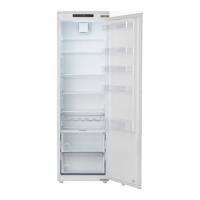ENGLISH 12
Troubleshooting
Problem Possible causes Solutions
The control panel is switched
o and/or the appliance does
not work.
There may be a problem
with the power supply to the
appliance.
Ensure that:
•
There is no power cut.
•
The power plug is properly inserted
in the socket and the bipolar power
switch, if present, is set to the correct
position (on).
•
The household electrical system
protection devices are in good
working order.
•
The power supply cable is not
damaged.
•
Switch the appliance on with the
power button.
The inside light does not work.
•
The light is broken.
•
Failure of a component
Refer to “Replacing the lighting”
Temperature inside the
compartments is not low
enough.
There could be various causes
(see the solutions in the next
column).
Ensure that:
•
The doors are closed properly.
•
The appliance is not installed near a
heat source.
•
The temperature is set appropriately.
•
Air circulation inside the appliance is
not obstructed in any way (see the
installation instructions).
Water ows on the oor.
The appliance tilts forward.
Tilt the appliance slightly backward (6mm
lower at the back). Refer to the separate
Assembly Instructions for more details.
The front edge of the
refrigerator next to the seal is
hot.
This is not a problem. It
prevents condensation from
forming.
No solution is required.
When the appliance is in fridge
mode, the temperature in the
compartment is too low.
•
The set temperature is too
low.
•
Compartment temperature
sensor malfunctions.
•
If no food in the compartment is
frozen, set a higher temperature.
•
If some or all food in the compartment
has become frozen, contact an
authorized Service Centre.
One or more indicators
on the control panel blink
continuously.
Refer to "Display" in operation
section.
Contact an authorized Service Centre.
Normal noises
It is normal for the refrigeration system to produce
some noises, such as gurgling and hissing.

